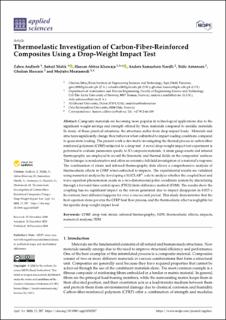| dc.contributor.author | Andleeb, Zahra | |
| dc.contributor.author | Malik, Sohail | |
| dc.contributor.author | Khawaja, Hassan | |
| dc.contributor.author | Nordli, Anders Samuelsen | |
| dc.contributor.author | Antonsen, Ståle | |
| dc.contributor.author | Hussain, Ghulam | |
| dc.contributor.author | Moatamedi, Mojtaba | |
| dc.date.accessioned | 2022-03-08T14:12:28Z | |
| dc.date.available | 2022-03-08T14:12:28Z | |
| dc.date.created | 2020-12-22T12:24:09Z | |
| dc.date.issued | 2021-12-28 | |
| dc.identifier.citation | Applied Sciences. 2021, 11 (1), 1-17. | en_US |
| dc.identifier.issn | 2076-3417 | |
| dc.identifier.uri | https://hdl.handle.net/11250/2983831 | |
| dc.description.abstract | Composite materials are becoming more popular in technological applications due to the significant weight savings and strength these materials offer compared to metallic materials. In many of these practical situations, the structures suffer from drop impact loads. Materials and structures significantly change their behavior when submitted to impact loading conditions as compared to quasi-static loading. The present work is devoted to investigating the thermal process in Carbon-Fiber-Reinforced Polymers (CFRP) subjected to drop test. A novel drop weight impact test experimental method evaluates parameters specific to 3D composite materials during the study. Strain gauge rosette and Infrared thermography are employed to record the kinematic and thermal fields on the composites' surface. This technique is non-destructive and offers an extensive full-field investigation of the material response. The combination of strain and infrared thermography data allows a comprehensive analysis of thermoelastic effects in CFRP when subjected to impacts. Experimental results were validated through numerical analysis by developing a MATLAB® code to analyze whether the coupled heat and wave equation phenomenon exists in a 2-D polar coordinate system by discretizing through a Forward-Time Central-Space (FTCS) Finite Difference Method (FDM). The results show the coupling has no significant impact as the waves generated due to impact disappears in 0.015 s. In contrast, heat diffusion happens for over one second period. This study has demonstrated the heat equation alone governs the CFRP heat flow process, and the thermoelastic effect is negligible for the specific drop weight impact load. | en_US |
| dc.language.iso | eng | en_US |
| dc.publisher | MDPI | en_US |
| dc.relation.ispartofseries | Applied Sciences;Volume 11 / Issue 1 | |
| dc.rights | Navngivelse 4.0 Internasjonal | * |
| dc.rights.uri | http://creativecommons.org/licenses/by/4.0/deed.no | * |
| dc.subject | Carbon-fiber reinforced polymers | en_US |
| dc.subject | Drop tests | en_US |
| dc.subject | Strains | en_US |
| dc.subject | Infrared thermography | en_US |
| dc.subject | Non-destructive testing | en_US |
| dc.subject | Thermoelastic effects | en_US |
| dc.title | Thermoelastic Investigation of Carbon-Fiber Reinforced Composites using Drop Weight Impact Test | en_US |
| dc.type | Peer reviewed | en_US |
| dc.type | Journal article | en_US |
| dc.description.version | publishedVersion | en_US |
| dc.rights.holder | © 2020 by the authors | en_US |
| dc.source.articlenumber | 207 | en_US |
| cristin.ispublished | true | |
| cristin.fulltext | postprint | |
| cristin.fulltext | original | |
| cristin.fulltext | postprint | |
| cristin.qualitycode | 1 | |
| dc.identifier.doi | https://doi.org/10.3390/app11010207 | |
| dc.identifier.cristin | 1862764 | |
| dc.source.journal | Applied Sciences | en_US |
| dc.source.volume | 11 | en_US |
| dc.source.issue | 1 | en_US |
| dc.source.pagenumber | 1-17 | en_US |

